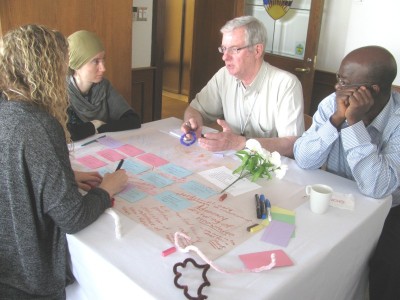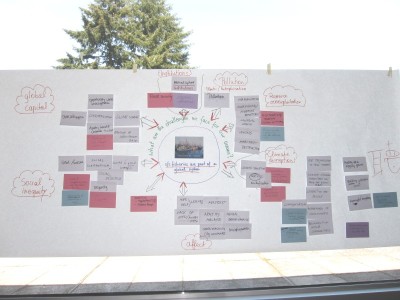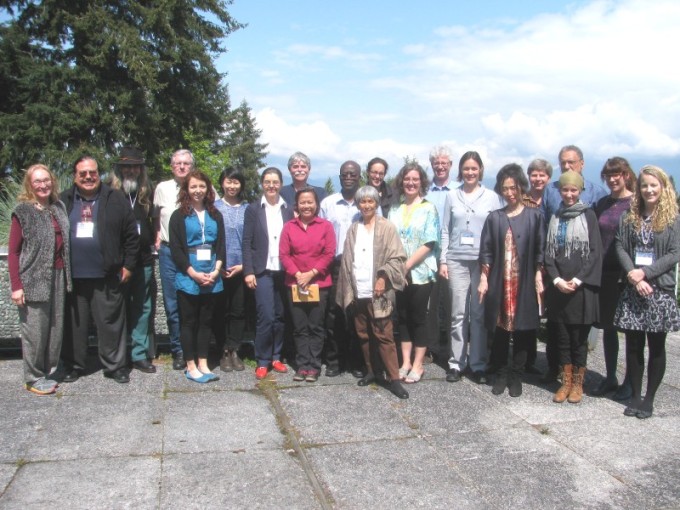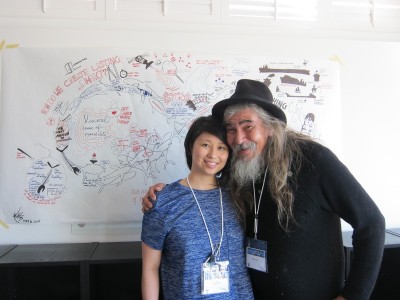Day Two - What do we already know?
Welcome and check-in
 The day started with some reflections about the experiences during the first day and a warm welcome to a few new participants, including Mel Wong, who joined offering her visual reporting skills to the roundtable during Day 2.
The day started with some reflections about the experiences during the first day and a warm welcome to a few new participants, including Mel Wong, who joined offering her visual reporting skills to the roundtable during Day 2.
Every participant contributed his or her perspective about the previous day and newcomers introduced themselves and what had drawn them to the roundtable.
While listening to the individual contributions, it occurred to Naomi that there were deep connections between the stories, which could be more readily expressed in Japanese and Chinese script where terms like sea, ocean, fishing, bay, law, politics and economics share a common root, much like different types of fish, listen, heart and breath do.
She quickly sketched some of the kanji and Japanese kana to illustrate her point.
Mindmapping
Having everybody attuned to the group and the day, Cornelia invited participants to the next step in developing shared understanding and sense-making around the question: what are the issues and challenges that we face for our seas?
Working in world café style groups of four or five per table for two to three rounds of about 20 minutes each, the ground rules were to have one person to accept serving as table host to ensure the continuity of the conversation. The other three or four people at each table then 'migrated' to other tables in successive rounds.
 The world café etiquette was spoken and available in printed form at each table to make sure that all ideas and opinions were accepted and received without judgement.
The world café etiquette was spoken and available in printed form at each table to make sure that all ideas and opinions were accepted and received without judgement.
The rich conversations at each table produced lots of ideas and cross fertilised the different perspectives of the participants. At the end, table by table, participants contributed their insights, written in the form of concepts on cards, one idea or concept per card.
They clustered the ideas by affinity to consolidate major themes ("branches") and their ramifications ("twigs") around the central question.
They added up to the following major themes in response to the leading question: Resource overexploitation, pollution, climate collapse, institutions, global capital, social inequality, human affect and emotions and connectedness of issues.
 In the final harvesting step participants identified a series of “levers” or entry points for action, what they estimated as most promising to bring about change.
In the final harvesting step participants identified a series of “levers” or entry points for action, what they estimated as most promising to bring about change.
“Prouds” and “Sorries”
Coming back from continued conversations over lunch, Ngaio started the afternoon session on a more reflexive note asking participants to team up in pairs and talk about
• What do I feel proud about that I am doing for these themes or issues?
• What do I feel sorry about that I am not doing or changing within myself?
Everybody could then write anomymously one or more prouds and sorries on a sticky note and post them. That was the perfect transition to the next step in the work flow.
Preparing learning journeys for the next day
Harking back to the principal “levers” or entry points for change, Ngaio then invited participants to propose issues to explore during the next day that would allow them to address one or more of the levers interesting them most and where their skills and contributions could make a difference. The following questions were intended to help form groups and prepare the learning journey that could take part or all of Wednesday:
- What can we learn from this place and its people, what stories can we hear?
- What will help us to explore these issues?
- Who will be our guides?
- How can we share our stories?
- What materials will we need on our journeys?
Three groups quickly came together on the strength of their shared interest in “meeting passionate people to help bring about change”, about the ambition to “engage ordinary citizens with the ocean through a potentially mobile exhibition”, and “producing a video about passionate people”. Some others preferred to go on individual journeys.

Wrap-up and check-out
 Just two highlights in response to Ngaio's invitation to reflect on their experience of the day:
Just two highlights in response to Ngaio's invitation to reflect on their experience of the day:
“There is so much energy in the room that was not yet there on Monday. It's amazing.”
“We can not imagine change before it comes about. But once it has happened, we can not imagine that change would not have come about. These are the limitations we need to keep in mind when working to support change.”
The visual harvest of an amazing day together was drawn by Mel Wong as the all-connecting life in the oceans forming a cycle which encompasses the creatures, the links between them and human interactions of different kinds. The drawing rendered the rich exchanges perfectly.








